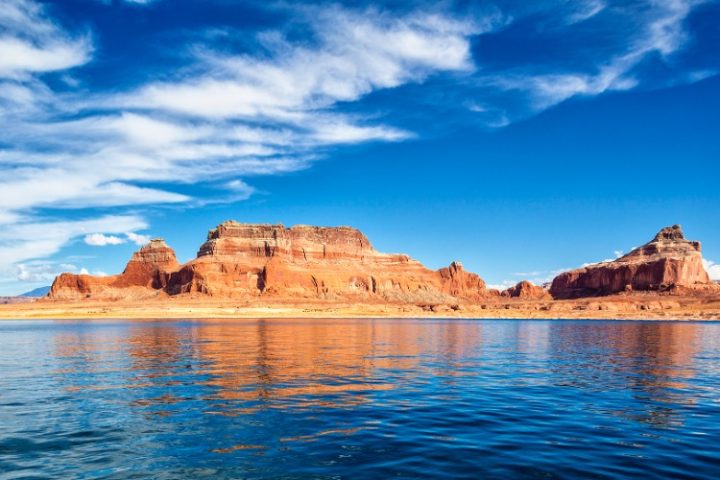
Long thought to be doomed by drought supposedly brought on by climate change, two major sources of water for the American Southwest appear to have rebounded nicely largely thanks to historic winter snowfalls. Both Lake Powell on the border of Arizona and Utah and Lake Mead the reservoir near Las Vegas have increased in depth by dozens of feet.
Dramatic satellite images from the European Space Agency (ESA) show Lake Powell, long thought to be a lost cause due to the region’s proximity to the desert as well as climate change, rebounding nicely due to snowmelt from winter storms that were 160-percent above average last winter. According to the ESA, Lake Powell has risen nearly 44 feet in the past several months.
While the rise in the reservoir levels is an unexpected and welcome surprise, experts warn that the Lake Powell and Lake Mead reservoirs remain well below full capacity.
For a while now, experts have been warning that the entire Colorado River system is in extreme danger of not being able to keep up with the demands for water in the region.
Even earlier this year, experts said it would take up to 50 years to replenish the reservoirs. It was said that the lakes would need six more years similar to 2011, a reasonably wet year by the region’s standards, to replenish the water table.
“We’d need six years like that (2011) to refill this system, in a row, based on current operating rules,” said Brad Udall, a water and climate scientist at Colorado State University. “And I just don’t see that even being remotely possible.”
But as last season’s snowfall proved, at least one tremendous year for snowfall was possible.
For many years now, a steady drumbeat of gloom has been predicted for the reservoirs.
“The harsh reality is this: Lake Powell is doomed,” wrote Robert Gehrke in the Salt Lake Tribune last August.
The region supplies water for up to 40 million people from California, Arizona, and Nevada.
The large amount of snow over the winter allowed the U.S. Bureau of Reclamation to release water through the Glen Canyon Dam at Lake Powell where it was also able to replenish Lake Mead.
In the past several decades, demand for the water housed in these reservoirs has increased greatly due to their use for hydroelectric power and an increase in population in the area. Experts are warning that the demand for water in the area has reached its max level.
In previous decades, “There was no Central Arizona Project, there was no Southern Nevada Water Authority, there was not nearly as much use in the Upper [Colorado River] Basin,” said Bill Hasencamp, who manages the Colorado River resources for the Metropolitan Water District of Southern California. “So the water use was low. So that filled up storage.”
Now with water demand at an all-time high, the region cannot simply depend on repeated snow-filled winters to replenish supply.
According to Gehrke, the region must look for alternative sources of water because Lake Powell won’t be able to keep up the supply forever.
“We can keep limping along, trying to shift water from one reservoir to another in a futile hydrological shell game. Or we can use the time we have, which may not be long, to prepare for life after Powell,” Gehrke wrote.
“[The] Colorado River is overallocated and the basin is experiencing 20 years of drought,” said Kathryn Sorensen, director of Phoenix Water Services, who added, “in the coming decades the flow of the river may diminish as much as 25 percent in the future,” jeopardizing one of the state’s main sources of water.
Climate politics being what they are, states such as California, Nevada, and Arizona that have such a huge demand for water and insufficient supplies, may want to use this sudden and, perhaps, brief time of plenty to rethink their options going forward.




